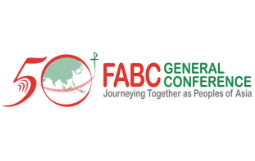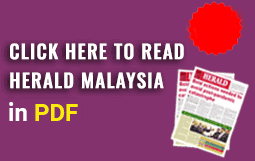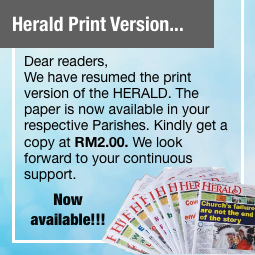Hope Telling
Jubilee of the World of Communications — sharings from Young Professional Communicators.
Feb 14, 2025

By Francisco Overee
From January 24-26, the Dicastery for Communications hosted the inaugural major event for the Jubilee Year of Hope, the Jubilee of the World of Communications. For the celebration, 150 young professional communicators from 70 countries were invited to participate.
I count myself blessed to have represented Malaysia and the Diocese of Malacca Johore at this Jubilee held at different places around Rome and Vatican. It began with an introduction and orientation session at the Lateran Palace on Jan 24.
At the Lateran Palace, we heard from two Jubilee team members, John C. Byrd and Alexandra Caroll who shared their vocation of working in the field of Communications. The message that they shared was clear: the work that they do is not merely a day-to-day job but a way to live out their baptism; a vocation. We were then given a brief historical overview of the Lateran Palace and proceeded to move through the Palace to the Basilica of St John Lateran. At the Basilica, we joined other people of goodwill for a penitential service and an international Mass for the Jubilee.
After the Mass, we returned to our lodging, this was the first informal time for the participants and it was during this bus ride that the most meaningful connections of the Jubilee started. I had time to get to know participants from Venezuela, Mexico, Costa Rica and Malta, all young people, just like me, who work in different areas of communications. It was in them and in their stories that I saw the fa c e o f the young Church, the ‘now of God,’ that Pope Francis talks about in Christus Vivit. It was an experience of courage and hope because even though we do not have a common language, we still tried to speak to one another, introduce ourselves and make jokes. During the orientation, the Dicastery for Communications encouraged that we share our pictures with the hashtag ‘hope telling.’ It was on this bus ride that I experienced this hope telling, in the new friends that I have made.
These friendships continued to grow as we arrived for dinner and were introduced to other young people, this time from Switzerland, Italy, the Philippines and Palestine. As we had dinner, we planned how we would go for the events the next day. We had to find our own way to St Peter’s Basilica and most of us had never been to Rome before. We decided that we would walk from our accommodation the next morning to St Peter’s together so that we would all arrive on time. On Jan 25, we started the day early with breakfast and then the slow walk down the Gianicolo towards St Peter’s as a group. Others decided that they would take the bus, but our small collective decided that we should walk, despite the cold and having to rely on Google Maps. A few wrong turns were taken, but we arrived at Piazza Pia on time.
From Piazza Pia, we began our pilgrimage to the Holy Door at St Peter. One participant was asked to carry the Jubilee Cross to lead the group. During the 20-minute walk from Piazza Pia to the Holy Door, we listened to the Pope’s Message for World Communications Sunday. Because the pilgrimage was in an open area, with many other groups walking in front of us and behind us, it was rather difficult to hear the reflection even though it was being read over a portable loud speaker. There was a group in front of us praying the Rosary and a group behind us singing the Litany of the Saints in French. This was a very moving experience, all of us, from different nations have travelled here for different reasons, but we were doing the same thing – the pilgrimage to the Holy Door.
After we passed the Holy Door, we entered the Basilica, I took some time to visit the tomb of St Pope John Paul II, the Blessed Sacrament Chapel and the tomb of Blessed John XXIII. We then exited the Basilica and proceeded to the Paul VI Hall for a cultural meeting and an audience with the Holy Father. The first speaker, Maria Resa, the founder and director of Rappler, an online news portal, was met with a three-minute standing ovation when she had finished her speech. She spoke about her experience being a journalist during the Duterte presidency in the Philippines and how she was charged with 10 different crimes for simply doing her job on reporting the truth of the presidency. Her courage and hope, despite all the obstacles she faced was inspirational and electric. Next, we listened to Collum McCann on the power of storytelling and how it can be used to communicate hope to listeners.
After these two speeches, there was a small concert as we waited for the audience with the Holy Father. The audience with the Holy Father was a vulnerable moment for communication. He spoke a mere five minutes, but he communicated a lot during that time. First, he joked about how he had a nine-page discourse to deliver that morning, which he chose not to deliver because he was not feeling very well and had decided to come to greet us and bless us. He passed his discourse to the Dicastery for Communications and said that we could read it by ourselves, he then spoke off the cuff encouraging us in our work in the field of communications and reminded us of the importance of truth, not giving in to sensationalising and gossip but communicating hope and beauty. He then apologised that he could not deliver his discourse saying that his arm was hurting and that he had a stomach ache. He proceeded to give us the apostolic blessing and then moved through the entire hall, greeting attendees.
After the audience, we went to the Vatican Canteen for lunch and then proceeded to the offices of the Dicastery for Communications for the afternoon programme. Here, we were presented with a panel of three speakers; Eli Pariser, Paterno Emasquel II and Chris Walter. Eli spoke about how we can create public spaces of the internet, “public parks” and “public libraries” of the internet in order to counter the current model of selling our attention to advertisements. Paterno spoke about how journalism could be practised in a synodal way and spoke mostly about his work as a journalist in the field of religion for the Rappler. Chris shared his work with producing documentaries. His style of documentary filmmaking is not one of excavating stories but rather allowing the storyteller to choose what stories they would like to share, how they would like to share it, and to which audiences. In his company, the storyteller has the power of the whole production rather than the company. This model of working might seem counterintuitive in the business sense but it has proven to be able to share stories in a more powerful way. Both Eli and Chris shared about how communications technology can be used and done in a synodal way even without using the word synod.
After this meeting, a few of us decided that we would take a walk before returning to our accommodation. We went to Castel Sant’Angelo and the Chiesa of Sant’Agnese in Agone to look at the beautiful artwork of Bernini and Michelangelo. This was a very light and refreshing time compared to the talks that we had to hear throughout the day. Even though the talks were good, I personally found that these times of informal communication which allowed the participants to share their own stories and lives with one another far more beneficial because it diverted from the traditional norms of communication, wasn’t forced and did not have a directed goal or programme, it was simply about sharing life, being companions on a journey.
A journey of ups and downs
On Jan 26, we proceeded to St Peter’s again for Mass (Sunday of the Word of God) that was presided over by the Holy Father. Pope Francis spoke of the importance of the Word of God in our lives and how God continues to communicate to us today in his Word. After the Mass, we joined others at St Peter’s Square for the Angelus.
In the afternoon, the final activities for the Jubilee programme were co n d u c te d with the keynote speech by Colum McCann and then a group activity of sharing stories with one another. The programme officially ended with dinner.
The next day, most of the participants would be leaving Rome by flight either in the afternoon or in the evening. A few of us who had time decided that we would take our own pilgrimage again to St Peter’s Basilica, this time we climbed the 300 plus steps to the cupola. This was a beautiful experience. At the top of St Peter’s, we shared with one another how this experience had been for us. One of our group members shared how life is like that journey up the cupola – the journey begins with large steps at first but then the steps become windy and at times steeped at an angle, with certain areas where you have to walk alone and you will have to wait to reach the top if someone stops halfway because only one person can walk at a time. But then you reach the top and the whole world opens up to you. The time spent at the top is not long, just a few minutes and then the descend begins.
The experience at the Jubilee for Communications has been like the journey up the cupola for me. It has its ups and downs. It opened myself to new experiences and perspectives, but now it is time to come back down. The challenge now, or rather, the opportunity that is opened to me now is how am I to communicate this hope that has been nurtured in me? What is my own hope story? In what ways can I communicate this hope daily and point others to that hope as well? I am still figuring these questions out, but one thing is certain, hope does not disappoint (cf. Rom 5:5).







Total Comments:0